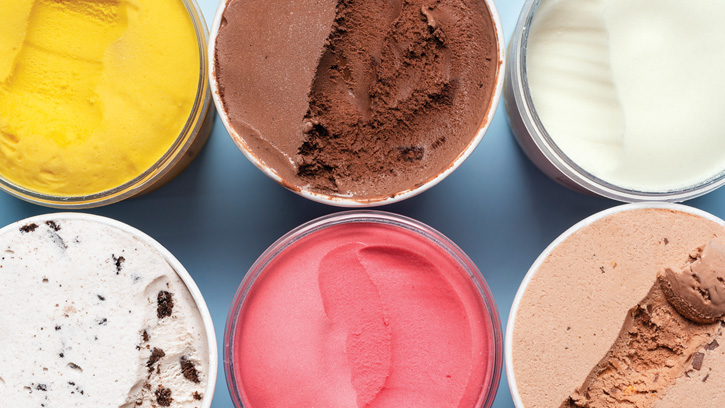Figuring Out Frozen Dessert Shrink
Science Forward | RESEARCH
The experience of opening a frozen dessert package and noticing space around the sides and top is both common and disappointing. And sometimes it leads to legal problems, as it did for frozen dessert maker Halo Top.
“Consumers would get the product, and it wasn’t full to the top like you would expect, and they sued Halo Top because the product didn’t meet their expectations,” explains Richard Hartel, professor of food engineering in the Department of Food Science at the University of Wisconsin–Madison. “But it was filled correctly; it just shrunk during storage.”
Frozen dessert shrinkage isn’t new, but it remains something of a mystery. That’s because there are many factors—from ingredients to transportation conditions—that can affect these desserts’ structural stability. There’s also been a 50-year lull in research, says Hartel, suggesting that manufacturers of the previous generation of frozen products had figured out how to manage the problem. “But recently, the problem has come back with some of these high-overrun products like Halo Top, and some new protein-type products that don’t quite behave the same way that dairy proteins do,” he says.
Hartel is a co-author of a new review paper published in Comprehensive Reviews in Food Science and Food Safety that investigates the possible factors that influence frozen dessert shrinkage.
Two Theories
“Frozen desserts are frozen foam, and all foams are unstable and will collapse over time, given the right opportunity,” explains Hartel.
This is a problem that’s tough to study, note the researchers, because the shrinkage often happens in processing facilities or once the product is in the supply chain, conditions that are challenging to recreate in a lab.
They have two main theories about ice cream collapse, according to Hartel. One is that frozen dessert companies are using newer ingredients in powder form that increase the protein content (particularly, ingredients like dried milk protein concentrate), but they’re not ensuring that the powder is fully hydrated after it’s added and before the entire mix is processed. That causes the proteins to release air and revert to their normal state, causing the foam to collapse, says Hartel. The second theory blames the constant temperature fluctuations that occur along the supply chain as the product is moved from one environment to the next. “As temperature goes up, volumes go up, and vice versa,” says Hartel. Once it’s expanded and collapsed, the foam no longer has the same rheological properties.
A Complicated Problem
Hartel says frozen dessert makers are eager for more insight into shrinkage. (The research was funded by the dairy industry, which is interested in learning about the role of some dairy products in this problem.) If the problem is that milk proteins are hydrating during storage and changing the surface structure of the foam and later collapsing, that suggests a longer rehydration time is needed, says Hartel. At warm temperatures, the proteins in the powder take hours to hydrate; it takes longer at lower temperatures, and much longer once the ice cream is frozen, he explains. “That tells the industry that they can’t just toss [the milk powder] in for 15 minutes at some warm temperature and expect it to work,” Hartel observes. “They should expect to get collapse if that’s the case.”
The researchers have been hydrating milk powders for different time periods and at different temperatures to see how those factors change the foam’s interfacial properties. Future research will involve making ice creams in the lab with those different characteristics and putting them in storage. “We want to see if we can confirm whether it’s hydration that’s causing the shrinkage or not,” says Hartel.
New technologies like sophisticated imaging systems that can monitor the air phase during storage and interfacial dilatational rheology, which can study the interior air, also hold potential for unraveling the mysteries of frozen dessert shrinkage.


